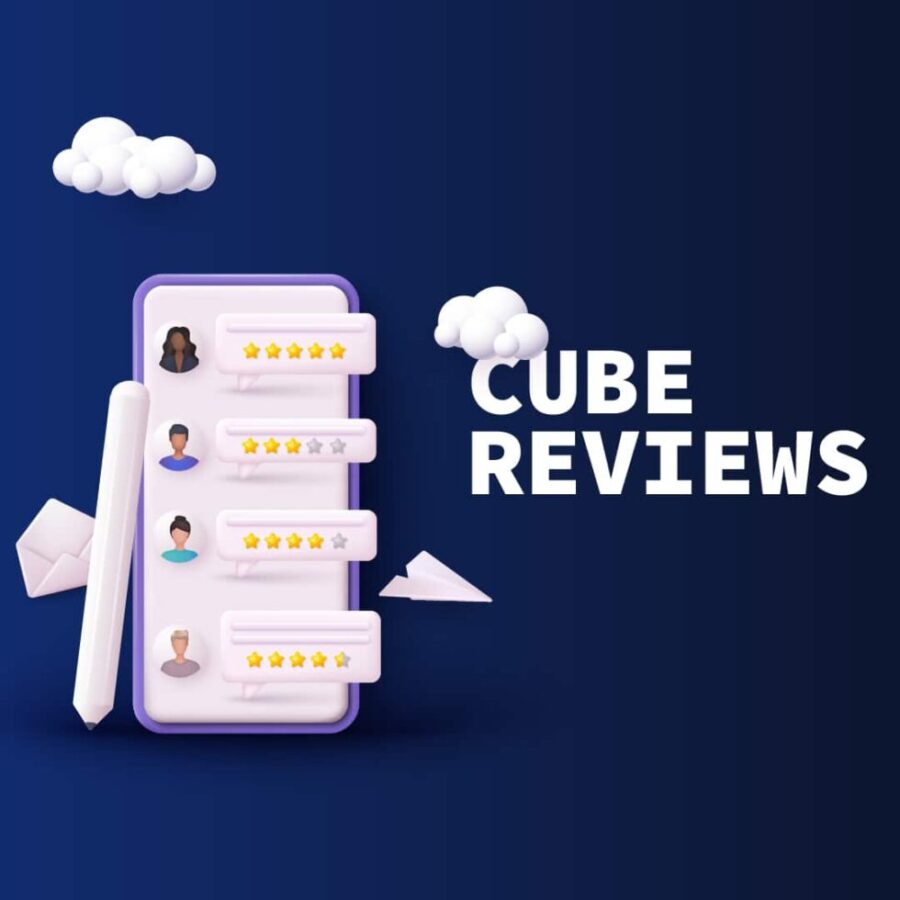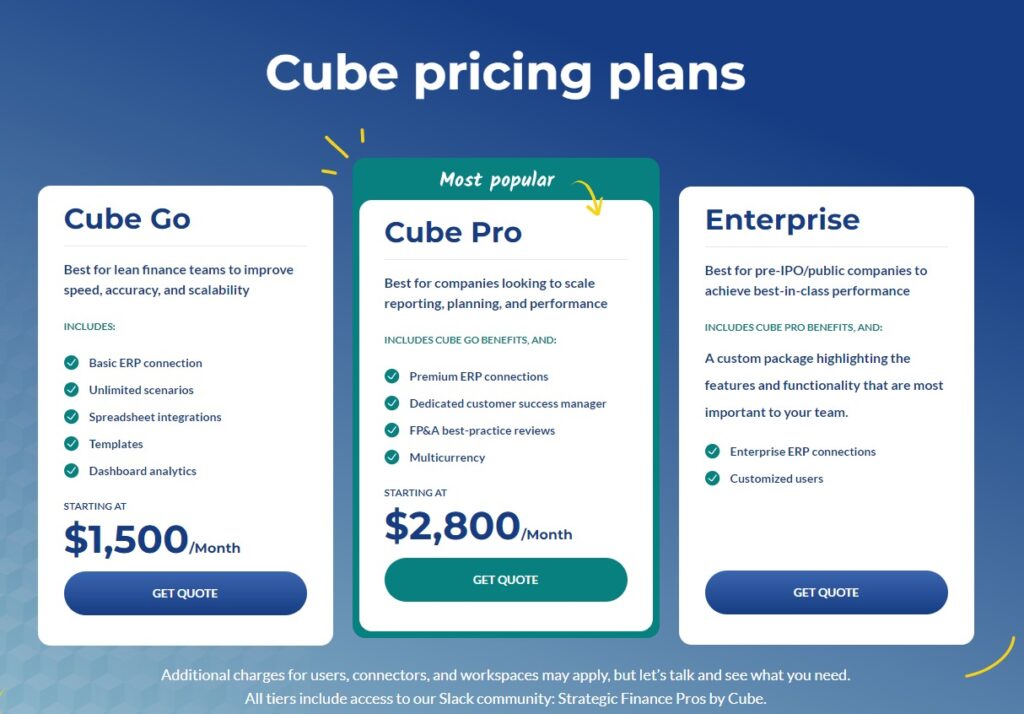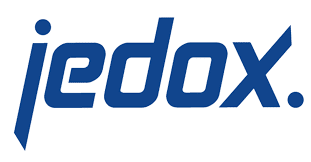
Contents
Introduction
Cube Software is a spreadsheet-native cloud based FP&A platform that improves companies budgeting and forecasting automation and accuracy.
While Cube Software is a great option for many companies and can greatly improve its financial processes, choosing an FP&A software that starts at $20k+ a year is a big decision.
This article will break down Cube’s pros and cons and highlight some important customer reviews to help you make the most informed decision.
Who is Cube Software for?
Cube was made for, and focuses on, small businesses. While companies such as Workday Adaptive Planning (large, enterprise corporations), and Datarails (small and medium sized scalable businesses) cater to certain customer bases, Cube’s platform focuses exclusively on small businesses and startups.
Highlights of Cube’s functions:
- Multi-scenario analysis Seamlessly model how changes to key assumptions affect overall outputs.
- Spreadsheet integrations Cube is compatible and bi-directional with any spreadsheet, including Excel and Google Sheets.
- Centralized formulas and KPIs Store all of your calculations in a central location and manage from a single source of truth.
- Multi-currency support Evaluate your financials in local and reporting currencies.
- Automated data consolidation Connect data from multiple sources for automated rollups and drilldowns.
Cube has some great functions and does a good job of consolidating and upgrading finance teams’ processes. Their growing customer base numbering around 300 organizations attests to that.
But let’s take a look at some customer reviews:
Cube FP&A Reviews
After analyzing dozens of independent reviews from Cube customers there are a few positive things that stand out:
- Single source of truth-Perhaps the number one reason why any organization wants to implement FP&A technology is having all company information easily accessible. A single source of truth avoids multiple spreadsheet updates and mistakes that Excel and Google Sheets are famous for.
- Automation- Another top reason for companies to use FP&A software is to automate all of the manual inputs that used to take up so much time. Whereas without FP&A software, finance teams used to spend up to 75% of their time on manual work, now customers are able to free up many hours. They can use that time to analyze and conduct other more productive tasks.
- Frequent upgrades-Cube is a young company and glitches are fixed through product feature updates and ready customer support. Reviewers point to benefits such as frequent product updates and listening closely to customer feedback.
Cube Limitations
However, Cube does have a number of limitations that buyers need to be aware of. Recent customer reviews on sites, such as G2 and Capterra, mention the following drawbacks of using Cube.
- Difficulties in uploading models -Customers experience consistent difficulties in uploading and arranging their operating model which are then coded and uploaded to Cube. One small company complained that they have to set aside “30 minutes to an hour” to run “imports from our accounting software Intacct to bring in actuals each month.”

- Limited drilldown – Another big challenge for sophisticated finance teams: Cube does not have drilldown capabilities (the ability to click on a certain statistic and see more detailed descriptions. For example, sales by geographic location or revenue broken down by time periods).

- Messy transfer of data- Cube has a “dimensional structure” giving users 4 predefined custom dimensions (for instance “finance Cube” and “HR cube). To transfer data between these “dimensions” is relatively complex. Users first have to publish it onto Excel and save the other Cube in Excel. Therefore for many users the process is not considered stable or secure.
- Limited dimensions – Companies that require granular or detailed level in reports find that Cube’s limited number of dimensions makes it difficult to do reporting flexibly or keep existing models used by companies pre-Cube. In fact, after analyzing over 7,000 calls with potential customers, we found that limited data dimensions was the main reason (cited 54% of the time) for companies choosing Datarails over Cube. For instance, one nonprofit complained that Cube does not allow them to report on a “number of different areas” and “having more dimensions available to us could make things easier”. In this way, Cube is one of the least flexible solutions.
- No AI capabilities – Unlike many FP&A vendors, Cube does not have AI capabilities. In contrast, next gen FP&A software uses simulation, optimization and ML-based statistical modeling that links corporate strategy to execution.
- Companies quickly grow out of Cube – For companies that are growing or scaling fast Cube is less optimal, though smaller companies report that Cube satisfies their needs. But when companies hit a certain size, Cube is unlikely to be able to meet their reporting requirements.

Cube Pricing
Cube has some very attractive pricing points, specifically for small businesses and startups in the “Essentials” plan. With a starting price of $1,500 a month, it is difficult to find another solution that comes close to that price range.
However, there are additional fees and limited features to keep in mind, especially with the “Essentials” plan:
- Although it’s priced per month Cube puts customers on yearly contracts with no free trial period (in contrast to other vendors that provide a free two week or month trial). This means that when choosing Cube, buyers must be absolutely certain that it is a smart choice or face being locked in for an entire year.
- Consulting is an additional fee of $250 per month (up to 4 hours/ month) – which again can quickly add up.
- The “Essentials” plan only comes with Quickbooks and Xero integrations.
- One time implementation fee for all plans which usually starts at around $5- $10K for small businesses and goes up from there depending on the size of the company and complications of the implementation.

Cube Alternatives
1. Datarails

Datarails and Cube are often compared as they are two of the best FP&A solutions that cater specifically to SMBs and startups. Datarails is a financial planning and analysis platform that automates data consolidation, reporting and planning, while enabling finance teams to continue using their own Excel spreadsheets and financial models.
Datarails highlights:
- Easy implementation –1-2 weeks for first output. 6-12 weeks for full implementation. Unlike all other vendors, Datarails takes on the entire implementation until the customer is satisfied.
- Superior customer service – for your entire time with Datarails customers get dedicated FP&A experts and regular catch-ups. In the words of one reviewer, “Datarails provides exceptional customer service before, during and after implementation. They were with us every step of customization and building reports and dashboards. The tool provided accessibility and timeliness of information to the business leaders and business analysts.”
- The only native Excel solution – Datarails is the only truly native Excel solution, so users who know Excel can perform just about anything in Datarails.
- Full, granular drilldown-In contrast to Cube, Datarails offers “full drilldowns in seconds” according to customers.
- Integrates with any source system -Datarails Integrates with any source system including CRM, ERP, and HRIS.
- Powerful workflows –Workflows allow for better collaboration and audit control along with automatic source data updates.
- Complete flexibility – Datarails supports unlimited dimensions. and allows you to keep any existing models or choose pre-defined ones.
- Integration across your business to provide a complete source of truth – Over 70 available software integrations- sales, marketing, HR, accounting. This helps transform business and move from “multiple versions of truth” to “one version of truth.”
- AI – Datarails is an AI-enabled FP&A tool, providing industry leading AI functions such as FP&A Genius, the Gen AI chatbot for finance, and Storyboards, the AI generated finance presentations.
Datarails Cons:
- Datarails doesn’t have full compatibility with Google Sheets and Mac although this is expected to go live soon.
- For small startups, other solutions such as Cube have a cheaper “Essentials” plan.
- Customer base is almost exclusively in the US, Canada, and the UK.
Datarails has nearly 20 case studies on their website highlighting how it has improved company’s financial performance and capabilities including:
Check out our full page of Datarails reviews.
2. Anaplan

Anaplan was founded in 2006 and caters to a wide range of customers serving a “connected planning” platform. Anaplan has complex analysis features and has above average adaptability to business and data structural changes.
Anaplan has a comprehensive solution that can be used to model any type of planning requirement and level of complexity, including planning models that incorporate data down to transactional levels.
Anaplan clients include corporate multinationals such as Coca Cola and Dollar General, which have petabytes of financial data to handle. They are the most likely buyers of this impressive and highly sophisticated Excel-killing software. These larger companies also have the resources for the lengthy implementation required, which takes up to a year.
Anaplan also has the ability to run impressive what-if scenario modeling on a cloud based platform that allows many users to be synced with the system. All of this makes it very attractive for its target companies.
Pros:
- Robust functionality allowing users to revert or view a model at any point in its history.
- Above average and consistent system upgrades.
- The graph display and KPI display options are endless.
- Consistent assumptions and calculations that occur in real time.
- Flexibility to quickly develop in response to business need.
- Robust history functionality allowing users to revert or view a model at any point in its history.
Cons:
- Endless option plans and customizable fields leave many customers overwhelmed.
- Integration with legacy systems is complex and resource intensive.
- Anaplan doesn’t have prices on the website, but reviewers point to the tool as one of the more expensive options.
- Difficult to implement in house. Usually need an experienced team or outside help.
3. Jedox

Jedox is one of the best overall options for finance teams as it is one of the few FP&A solutions that caters to small, medium and large businesses. The company was founded in 2002 and has been a stock corporation since 2008.
Although most FP&A solutions provide Enterprise Performance Management, Jedox specifically advertises as an EPM platform. In addition, customers have the choice of cloud-based or on-premise models which is a nice attraction point for many.
Jedox also has very good integrations and contains one of the largest numbers of well rounded integrations. Here are a few examples:
- BI and Analytics- Microsoft Power BI, Qlik Sense, QlikView, Tableau and more.
- Databases- Microsoft SQL Server, Oracle Database, IBM DB2, SAP HANA, MySQL and any other relational database via JDBC driver.
- ERP/ CRM- SAP ERP, Salesforce, Microsoft Dynamics 365/Nav, Oracle Netsuite, Infor and more.
- File based connections- File-based data sources include Microsoft Excel, Microsoft Access CSV, JSON, XML, Directories and more.
Pros:
- 14 day free trial. Jedox remains one of the few FP&A solutions that still provide this.
- Above average scalability thanks to the wide range and large number of customers.
- Flexible modeling capabilities.
- AI Assisted planning that is especially helpful for corporate management.
- All in one performance management solution that controls the entire value chain.
Cons:
- Complex projects require expertise of specialized consultants.
- Many customers reported “a need for ongoing maintenance and support during upgrades”.
- Needs coding or professional services to take full advantage of all the functions.
- Excel add-in is less responsive when running with other add-ins. Makes it less efficient in comparison to softwares with native Excel.
- Difficulty in creating and customizing dashboards and workflows.
Conclusion
Cube is one of the leading FP&A software solutions for startups and small businesses. Cube has a 4.5-4.7 rating on all of the leading software review sites and comes with many functions that will reduce manual work and increase insights into financial data.
Ultimately Cube works best for:
- Startups and small businesses.
- Companies looking for a cheap and basic plan to gain better insights into FP&A.
- Finance teams that rely heavily on Mac or Google Sheets
However, companies that are looking for an FP&A solution that covers the following:
- Completely native Excel that reduces onboarding time and doesn’t require coding knowledge.
- Solutions that are built for scalability and growth.
- Unlimited dimensions.
- Industry leading AI tools.
- Easy to use workflows and audit control…
Might find Datarails as a better fit for their organization.